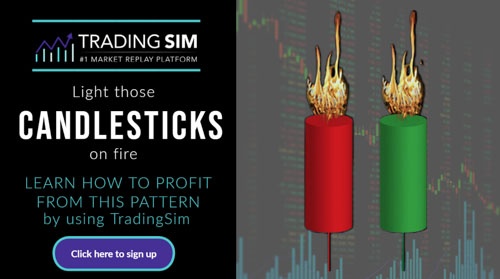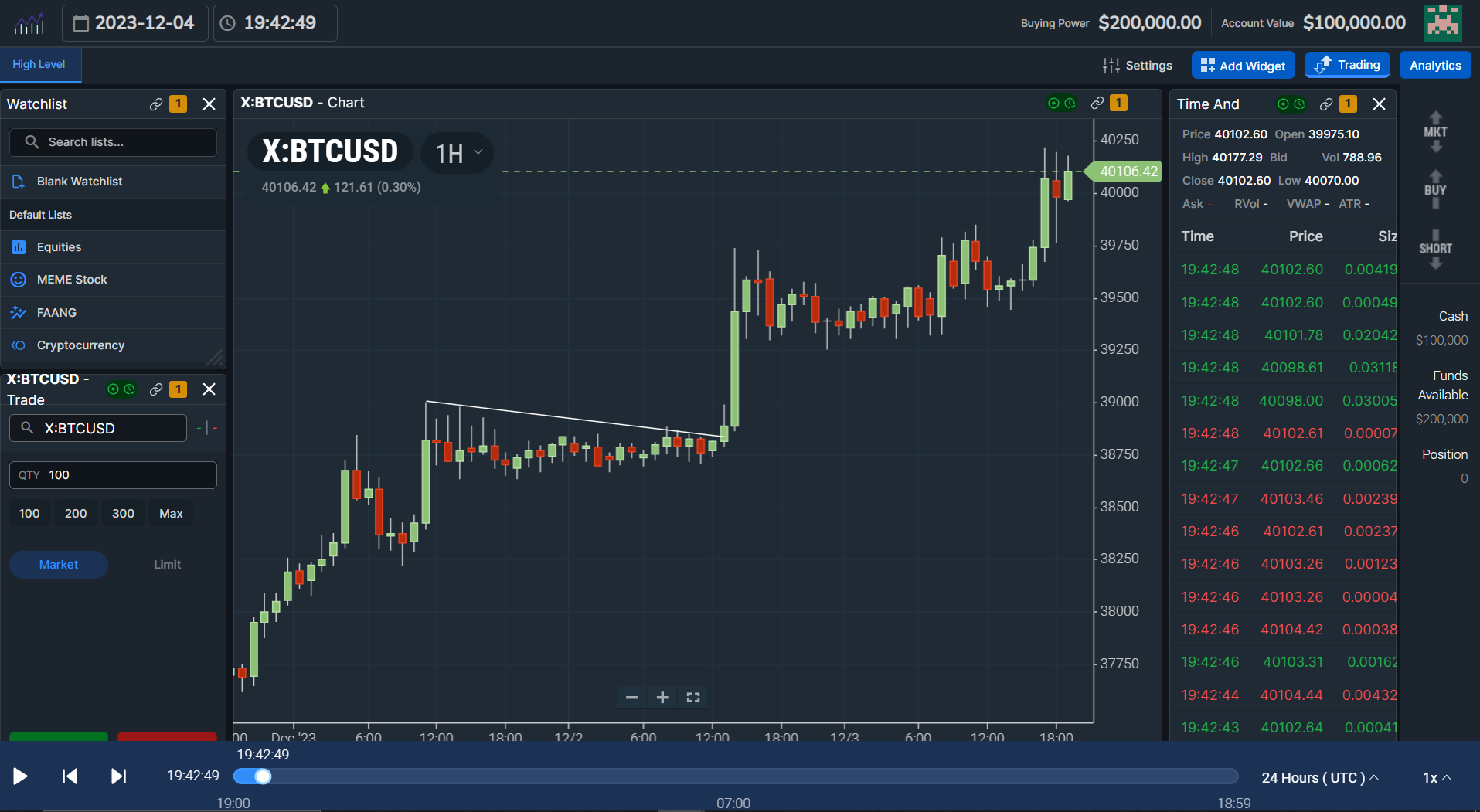Discover the world of paper trading and learn how to get started with this comprehensive beginner's guide. From understanding the concept to mastering the strategies, this blog post will equip you with all the knowledge you need to succeed in paper trading.
What Is The Meaning of Paper Trade?
A paper trade is a simulated purchase of a stock, bond, cryptocurrency, or other financial instrument without using real money. Paper trading allows aspiring and experienced traders to test their trading strategies, learn how the market works, and gain experience in a risk-free environment.
In paper trading, trades are placed through a brokerage platform or charting software that has been “switched” to paper trading mode. Within these systems, traders can create a virtual portfolio and execute trades based on real-time or historical market data. Virtual accounts are set by the user based on realistic capital investments, and can usually be reset no matter the gains or losses you incur. Similarly, traders can track their performance, analyze the outcomes of their trades, and make adjustments to their strategies without risking any actual capital.
Understanding paper trading is essential for beginners who want to enter the world of trading with a leg up. It can prepare you better than those who jump in without practice. It provides a safe and controlled environment to observe different trading strategies, technical analysis, and market dynamics. And, it can also help develop the discipline and emotional control required for successful live trading.

Does Paper Trading Actually Help?
There are several benefits of paper trading for both beginners and experienced traders. You may be thinking, why would an experienced trader want to paper trade? The simple answer is that active traders are always looking to refine their strategies, add or tweak criteria for their entries and exits, and simply search for better ways to trade.
Good traders know that the market changes. While time-tested strategies may continue to work, the circumstances often change. A paper trading simulator provides a risk-free playground to observe, review, and backtest new and modified strategies so that your capital isn’t wasted on guessing in live markets.
Reasons To Start with Paper Trading
Here are five of the best reasons we can come up with for using a paper trade platform:
1. Risk-Free Learning: Paper trading allows you to learn the ins and outs of trading without risking your hard-earned cash. You'll be able to experiment with different strategies, analyze market trends, and understand the impact of various factors on your trades.
2. Building Confidence: Practice in any performance-based activity helps you gain confidence. This is what a paper trading simulator can do for you: allow you to test your strategies, identify your strengths and weaknesses through review, and make improvements before entering the real market.
3. Understanding Market Dynamics: Paper trading also provides a platform to understand how the market works in general. You need to know how different securities are traded and how various economic and political factors can impact prices. Studying this through a virtual trading system will help you develop a solid foundation of market knowledge.
4. Testing Strategies: Paper trading allows you to test different trading strategies without risking real money. One of the best ways to use this is alongside your mentor or trading educator's materials. Test their strategies without being a blind follower and see how they work.
5. Tracking Performance: Some simulators, like Tradingsim, allow beginners to track their performance and analyze their trades. You'll be able to identify patterns, evaluate your decision-making process, and learn from mistakes without any financial consequences.
Overall, paper trading is an invaluable tool for beginners to gain experience, build confidence, and develop their trading skills before entering the real market.
The Negatives of Paper Trading
While the benefits of paper trading outweigh the disadvantages, they are worth noting. Keep in mind that it is the mindset and attitude you carry with you while practicing that matters most. Use a paper trading application to play around and waste time and it isn’t likely you’ll get much benefit.
Think of it this way. Would Lebron James get much out of his practice sessions if he just threw his shoes on and went out to shoot around for a few hours? How would that prepare him for his next game? How would he focus on strengthening his weaknesses without focused effort?
Trading is no different. You get out of it what you put into it. Know there is a market correction on the horizon? Why not study what small cap stocks typically do during market downturns. Study the historical charts to find patterns and determine when and where your strategies work best, or when you need to sit on the sidelines.
Things to Consider When Paper Trading
That being said, here are our five paper trading considerations you need to be aware of:
1. Lack of real consequences: The absence of real financial gains or losses can lead to complacency or unrealistic risk-taking behavior. The adrenaline rush and emotional pressure of real-world trading are missing, which can affect your decision-making process.
2. Limited market simulation: Paper trading platforms may not perfectly replicate real-market conditions. Factors like bid-ask spreads, order execution delays, and liquidity limitations might be oversimplified or absent, leading to unrealistic trading experiences.
3. Psychological disconnect: The virtual nature of paper trading can create a disconnect from the emotional and psychological aspects of real-world investing. The fear of losing real money and the thrill of real-world gains can significantly impact your trading behavior.
4. Overconfidence trap: Successful paper trading results can lead to overconfidence and unrealistic expectations in the real market. Remember the old investing disclaimer that past performance is not indicative of future results. Real-world trading involves complexities and risks not fully captured in simulations.
5. No substitute for experience: Paper trading can provide valuable knowledge and practice, but it's not a replacement for real-world experience. The dynamic nature of real markets, unforeseen events, and emotional challenges can't be fully replicated in a simulated environment.
Can You Make Money Paper Trading?
While the clear answer is no, you can't make real money in paper trading, paper trading offers certain advantages that can help you make money in real markets. Paper trading uses fake money, virtual money. However, if you use a trading simulator properly to assess and learn strategies, you may be better prepared to enter live markets and make real money.
Is Paper Trading Good or Bad?
Paper trading is only as good as the trader who uses it. Many traders get their start in a simulator long before they put their hard-earned cash to work. It is inside these training grounds that smart beginners test strategies from "gurus" and market educators.
Where Should a Beginner Start Trading?
You see, the barrier to entry for getting involved in the stock market is extremely low. Perhaps this is on purpose, as markets need liquidity, and untrained investors lose money more often than not. For that reason, paper trading is an excellent choice for beginners. It takes away the emotional rollercoaster and early trauma of taking losses in the markets and replaces it with sound market experience.
We'll give you some tips and tricks for how to make the most out of paper trading below. But for now, suffice it to say that if you begin trading by paper trading, you're more likely to succeed without the pitfalls that most new traders face. It's all in the amount of time and energy you spend learning and observing while preserving your capital.

Getting Started with Paper Trading: 6 Easy Steps
New and developing software applications have made it easier than ever before to get started in paper trading. However, not all options are the same. Before you get started, it will save you time to decide what your goals are first.
For example, do you want to ONLY trade the open market each day on the platform you plan to use with your broker? Or, do you want an application that allows you to test strategies through live OR replayed markets? In addition, how realistic does the replay need to be? Do you need realistic market data and Level II data? Historical market scanners for day trading?
Whatever you decide will affect the type of paper trading platform you need. If you’re still deciding, be sure to check our comparison of the top paper trading platforms on the market right now.
PRO TIP: Choose a platform that allows you a free trial before you invest in a monthly subscription, like TradingSim.

On that token, follow these 6 simple steps to get started with a paper trading application:
1. Choose a Paper Trading Platform: Several online platforms offer paper trading services. Research and select a platform that suits your needs and preferences.
2. Sign Up: Create an account on the chosen paper trading platform. Some platforms may require you to provide personal information and complete a verification process.
3. Explore the Platform: Familiarize yourself with the features and tools offered by the platform. Learn how to navigate the interface, access market data, and execute trades.
4. Set Up a Virtual Portfolio: Create a virtual portfolio by selecting the securities you want to trade and allocating virtual funds to each position. Treat this portfolio as if it were real money.
5. Start Trading: Use the platform's trading tools to execute trades based on real-time market data. Monitor your trades, track their performance, and analyze the outcomes.
6. Learn and Improve: Continuously learn from your paper trading experience. Analyze your trades, evaluate your strategies, and make adjustments based on your findings.
Remember, paper trading is a learning process. Don't be afraid to make mistakes and experiment with different approaches. Use this opportunity to develop your skills and gain confidence. At the very least, develop your chart eye, and don't place real trades until you know your performance metrics for any given strategy.
Developing a Paper Trading Strategy
Here is where the rubber meets the road. Without developing a paper trading strategy, you’re wasting your time and money. The great thing is, you don’t have to start from scratch. There are plenty of trading strategies you can test and tweak on your own. We’ve written about many of them here.
Tips for Creating a Paper Trading Strategy
Determine your objectives and what you want to achieve through paper trading. Are you looking to test specific strategies or learn about different markets? Or both? Keep in mind that different market environments can affect strategies in different ways.
Conduct thorough research on the markets, securities, and trading strategies you are interested in. Use technical analysis, fundamental analysis, and other tools to identify potential opportunities.
Most importantly, set your risk parameters. Defining your risk tolerance and setting limits on the amount of virtual capital you are willing to risk per trade or per day is the most important decision you’ll make, regardless of your strategy. Avoiding heavy losses is the key.
There are several trading educators and mentors on the web. If you’re looking for a good starting place to learn, be sure to check out our podcast where we interview some of the more successful traders in the US markets. Follow one or two or all of them, take what they teach, and apply it to your paper trading research.
Remember, developing a paper trading strategy takes time and practice. Be patient, stay committed, and continuously learn from your experiences.
Paper Trading vs. Live Trading: What’s the Difference?
Live trading carries with it significant emotional challenges that paper trading may not conjure. When your real money is on the line, the risk is real. And for unseasoned traders, this may create a whirlwind of emotions in the heat of the moment.
Without proper training, live trading is akin to gambling. Not having a strategy and sticking to it can bring out the worst in you. Likewise, if you’ve experienced any success at paper trading, your confidence might have you ill-prepared for the unpredictability of the markets.
Additionally, paper money drawdowns never hurt quite like real money drawdowns. When the latter happens, self-discipline to cut losses and manage your risk can disappear just as quickly as your hard-earned capital. Keep that in mind.
Lastly, greed is very real. Despite what Dave Portnoy might say, stonks don’t go up forever. What goes up will eventually come down. It is called the Wyckoff Price Cycle. Look it up. It will do you well to understand the rise and fall, boom and bust of market bubbles and cycles. Set rules for taking profits, just as you would taking losses, and stick to them!
Is Paper Trading Good for Day Traders?
Absolutely. We would argue that day traders can benefit most from paper trading as volatility is heightened during the day. Paper trading allows you to learn the strategies and ins and outs of 1, 5, 15, 30-minute, and hourly charts. Don't take our word for it, check out our interview with successful day trader and mentor, JTrader.
Tips for Successful Paper Trading
In light of comparing paper trading to live trading, let’s consider a handful of tips to help ease the transition between the two. But remember this, no performance athlete ever fully leaves the practice arena for good, especially if he/she is still performing on the stage, the court, the arena, or the field. Keep coming back to fine-tune your playbook.
To make the most out of your paper trading experience, consider these tips:
- Treat it Seriously: Approach paper trading with the same seriousness and dedication as you would with real trading. Please take it as an opportunity to learn, practice, and improve your skills.
- Use Realistic Parameters: Set virtual capital, position sizes, and risk parameters that reflect your actual trading goals and risk tolerance. This will provide a more accurate simulation of real trading conditions.
- Keep a Trading Journal: Maintain a trading journal to record your trades, strategies, and observations. This will help you track your progress, identify patterns, and learn from your experiences.
- Embrace Simulated Market Conditions: Consider the limitations and differences of paper trading compared to real trading. Understand that slippage, liquidity, and execution speed may vary in real market conditions.
- Experiment with Different Strategies: Use paper trading as an opportunity to test different trading strategies. Explore various approaches, indicators, and timeframes to find what works best for you.
- Learn from Successful Traders: Study the techniques and strategies of successful traders. Read books, watch educational videos, and follow reputable traders to gain insights and inspiration.
Most importantly, keep in mind that progress takes time. Most successful traders never realize profitability until many years of trial and error. It takes years of losses to figure out what works even for the best of traders.
Conclusion
We hope you've found this beginner's guide to paper trading useful. Standing at the edge of the world of investing can seem daunting and sublime. It can be a harrowing experience not knowing where to start or how to start. We hope that you'll begin your journey by paper trading.
We've got a 7-day free trial for you here at TradingSim.com, where we're home to 1000s of budding and experienced traders just like you. Begin your journey with us, and test your knowledge in our proprietary trading simulator that allows you to trade with real market data and replay 24/7.












 Day Trading Platform
Day Trading Platform 
